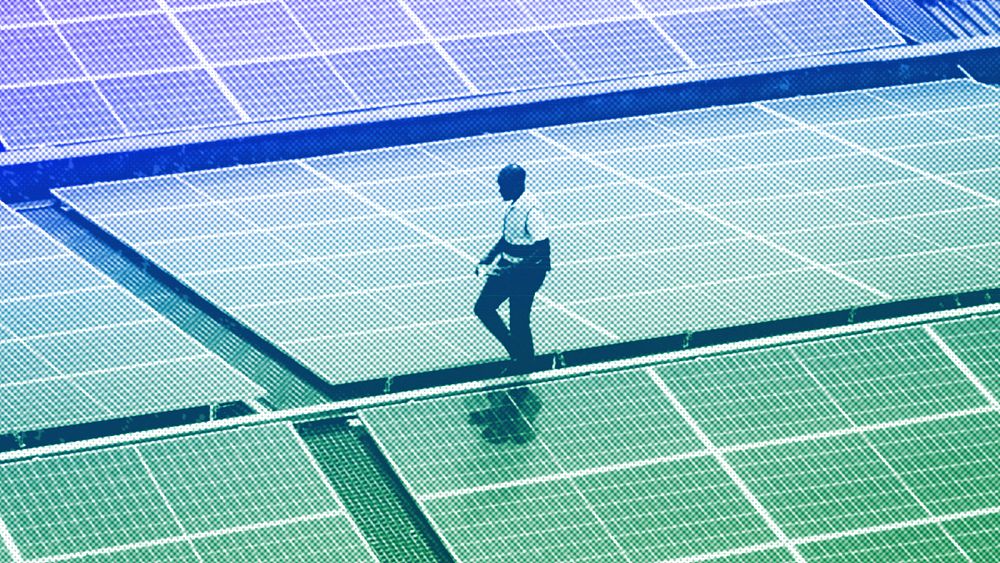We have a chance now to create a fair and clean global energy system

The opinions expressed in this article are those of the author and do not represent in any way the editorial position of Euronews.
The rapid wind down of fossil fuels is important, but it must happen in tandem with the rapid deployment of integrated renewable energy systems that are good for the consumer and the climate, Dan Hamza-Goodacre writes.
As politicians, royalty, lobbyists, and campaigners flock to the Gulf in the coming weeks, the process has already been overtaken by controversy: the Abu Dhabi National Oil Company’s alleged angling for business at what is supposed to be a high-level diplomatic event.
COP President Sultan Al Jaber had previously said he was keen to get fossil fuel energy companies around the table at this year’s climate summit.
It’s not a totally unreasonable idea — after all, they will have to be part of any plan to cut emissions and use of fossil fuels.
But there’s a danger that as we focus on the machinations of the fossil fuel lobby, we lose sight of the enormous opportunities that are opening up for creating a more efficient, open and sustainable energy system.
Fossil fuels are done for
A few things are clear, and despite lobbyists’ efforts, not really up for debate.
First, the age of fossil fuels — of combustion engines, gas heating, and the other innovations of the past 150 years or so — is coming to an end. It may be drawing to a close too slowly for many, but there is no way back.
Second, the world needs increased electricity generation and storage capacity to deal with this shift. And finally, the disruptive global phenomena of the last few years — first with the COVID-19 pandemic and then the war in Ukraine, have highlighted the need for localised and decentralised energy systems.
In the coming decades, we will need to be in a position to deliver three times more electricity than we currently do, cleanly and quickly.
To address this, a shift in how, when, and where energy is produced is imperative.
As government, business and finance delegates seek to discuss issues around energy and money at COP28, developing fully integrated energy systems needs to be at the forefront of these discussions.
We urgently need “on-site, on-road, on-grid” systems in which buildings, infrastructure, and electric vehicles (EVs) all play a role in generating, storing and sharing energy.
What is a ‘virtual power plant’?
Imagine a simple scenario: your house, including heating and cooking, is fully electrified, with solar panels on the roof. Your electric vehicle has a battery that can power your house for three days.
Both house and vehicle are consuming and generating electricity: either can be used to charge the other with a simple charging cable, and any surplus you generate is sold to the grid.
Now imagine that system at scale, employed by offices, buses, schools, supermarkets, vans, government departments…. What you have created is the “virtual power plant”. It’s doable, and most importantly, it’s scalable.
In Mexico, the city of Hermosillo authorities solarised a new fleet of EV police cars, effectively doubling as an energy provider. Rwanda’s largest supermarket chain, Sawa City, benefits from a rooftop PV and battery system and electrified e-bikes for deliveries.
Downtown Take-Aways in Nigeria is powering its facilities and a Pay As You Go EV charging service with its on-site solar and storage. They are all saving on their energy bills and making immediate contributions to reducing emissions.
In Australia, meanwhile, Origin Energy created the Loop — a virtual power plant of over 275,000 connected devices like those in Hermosillo, Sawa City and Downtown.
This virtual power plant produces 815 MW of electricity — equivalent to a large power station. In fact, rooftop solar is producing so much electricity that some Australian consumers are actually paid to charge their EVs, or other devices, using the excess power.
And in the US, energy company CPower has created a 6.3Gw virtual power plant — more than twice the size of the UK’s Hinkley C nuclear power plant.
The global energy system is being reshaped before our eyes
Decentralised energy networks are more resilient than centralised grids as different parts of the system can be called upon at different times.
Energy stored in batteries can be distributed to the grid during moments of peak demand or outages. As Storm Elliott battered the US a year ago and a gas plant went down, C Power’s virtual power plant was able to supply enough energy to 1.7 million homes, considerably lowering pressure on the grid.
The technology is accelerating at pace across Europe. In February, telecomms company Elisa announced Europe’s largest VPP in Finland, with an expected capacity of 150 mWh.
This was quickly superseded in August with the announcement of the Sonnen VPP in Germany, which, the company claims, will reach one gigawatt per hour “in the next few years”.
The global energy system is being reshaped before our eyes. We have a chance now to create a global system that is equitable, economical, clean and resilient.
The United Nations Framework Convention on Climate Change, which underpins the COP deliberations, stipulates that all parties should “promote and cooperate in the development and transfer of technologies that reduce emissions of greenhouse gasses”, and obliges countries to share that technology.
Spreading integrated renewable energy systems across the globe should be a top priority for every delegate in the Emirates these days.
The rapid wind down of fossil fuels is important, but it must happen in tandem with the rapid deployment of integrated renewable energy systems that are good for the consumer and the climate.
Dan Hamza-Goodacre is the founder and Chief Energy Officer at Integrate to Zero, and has over 20 years of experience working on climate and sustainable development.
At Euronews, we believe all views matter. Contact us at [email protected] to send pitches or submissions and be part of the conversation.
Source: Euro News














